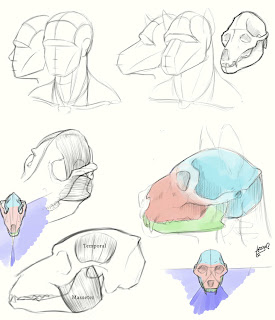 |
| Some main human facial movements compared with those need for an anthro' character with a longer muzzle. |
Tuesday, 20 November 2012
Expression
Sunday, 18 November 2012
Skull Ideas
Sunday, 4 November 2012
Comparative Skull Proportions
Each skull is divided simply into 3 parts; red - the maxilla and the plains of the 'face'; green - the mandible; blue - the cranial vault; yellow - the Axis (1st cervical vertebra). Each represents to a rough scale the respective size of each skull element in a) human, b) canine and c) equine. Note the cranial vault does not directly represent respective brain size.
I've started with a thought on the sentient issues of anthro' characters. We would expect our characters to the be the singing, dancing types of the average human. So if we take the casual assumption that to have the same level of intelligence means having the same brain size of a human we soon need to adjust the proportions of the skull to accommodate this. Fig 2 indicates a size of the cranial vault in blue of a human (a) that we'd need to apply to our animal skulls. How then do we balance this with the large jaw and jaw muscles of a herbivore or carnivore? What changes does a larger cranium make to that of the facial plains, particularly the Zygomatric (or cheek bones), the position of the eyes and visual field? We have a number of considerations to make and plenty of permutations dependent on species...
Labels:
anatomy,
canine,
comparative,
equine,
furry,
human,
proportions,
skull
Subscribe to:
Posts (Atom)




